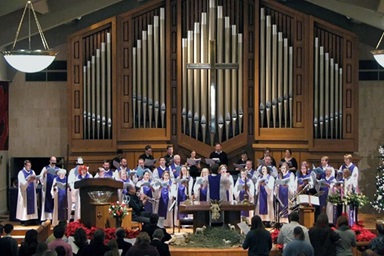Little boys clamor to play the wise men in the Christmas pageant before agreeing to play him. In a typical Nativity set, he can be easy to mistake for a shepherd.
No question: The reserved, unobtrusive Joseph tends to hover in the background in our retellings of Christ’s birth.
But Joseph gets his due in the Gospel passage Matthew 1:18-24. This is Joseph’s big scene, and the example he sets still offers lessons for Jesus’ disciples — and fathers — today, say scholars and pastors.
“Like others in our salvation story, God turned Joseph’s life over, but Joseph always had a choice to follow or not,” said the Rev. Jarrod Johnston, an avowed "liturgy nerd" and associate pastor of communications and young adult ministries at First United Methodist Church in Arlington, Texas.
Johnston wrote about Joseph in the sermon series Hope is on the Way, which the United Methodist Board of Discipleship shared in Advent in 2012.
“(Joseph) chose to take a risk for God, and that’s an example we can all follow.”
‘A righteous man’
The Holy Family’s beginnings were anything but Christmas-card perfect.
The Gospel of Matthew makes clear that Mary’s pregnancy was a scandal. Sure, she was with child by the Holy Spirit, but Joseph either did not know or did not believe Mary’s story.
So, the couple’s engagement was falling apart, and the Virgin Mary faced the strong likelihood of becoming an unwed mother. In first-century Galilee, such a broken home could have dire — even deadly — consequences.
Matthew also says Joseph was “a righteous man.” That means he was obedient to the Torah, the law of Moses, say biblical scholars.
“You need to understand that betrothal in his culture is the first act of marriage,” said the Rev. Ben Witherington III, a New Testament professor at Asbury Theological Seminary in Wilmore, Ky. “So it really is a matter of divorcing Mary, and there must be a sufficient cause, in this case, assumed adultery.”
Witherington, who is also an ordained United Methodist elder, has written more than 30 books on the New Testament, including a commentary on Matthew.
He points out that it was significant that whatever sense of betrayal Joseph might have felt, he wanted to part ways from Mary “quietly.” The alternative would be to press charges against her before the local religious elders, not only publicly humiliating Mary but also putting her at the same risk of stoning faced by the adulterous woman Jesus later encounters.
“But still she will have been shamed and seen as damaged goods thereafter,” Witherington said, “probably impossible for her to marry in that locale thereafter.”
A heeder of dreams
Nevertheless, as Matthew shows, Joseph was open to heeding fresh guidance from God. In a dream, an angel tells Joseph that the child his betrothed is carrying was indeed conceived by the Holy Spirit and will be the Immanuel promised in Isaiah.
“Dreams in the ancient world were understood (for the most part) as means of divine communication,” said Derek S. Dodson, the author of “Reading Dreams: An Audience-Critical Approach to the Dreams in the Gospel of Matthew.” “The dreams (in Matthew) are divine encounters that mostly function to protect the child Jesus. … As divine communiqués, dreams are part of Matthew’s portrayal of Jesus’ origin/beginning as providential.”
Some biblical scholars have pointed out similarities between Matthew’s account and the Bible’s other dreaming Joseph (he of the keen fashion sense and scheming brothers). Matthew’s genealogy in the first chapter even lists the father of the New Testament Joseph as also named Jacob, though Luke’s genealogy gives Joseph’s father a different name.
But Dodson, a lecturer in the religion department at Baylor University, in Waco, Texas, is not convinced the Gospel writer deliberately is evoking the Joseph of Genesis.
“The dreams associated with the Genesis Joseph are all symbolic dreams that require interpretation; and the Genesis Joseph is the dream interpreter par excellence,” Dodson said. “The Matthean dreams are not symbolic nor in need of interpretation. They are visitant dreams that give directives to Joseph, who simply obeys.”
That openness to God is one of his key attributes worth following.
“(He) is open to doing what the heavenly vision suggests, even though now it may cost him his reputation as a righteous man,” Witherington said. “This says something about his courage and faith in God.”
Joseph’s attention to his dreams continues to save Jesus’ life. In Matthew 2:13, he follows a dream’s warning to flee with his family to Egypt and escape the murderous Herod. When Herod dies, Joseph receives a dream to return. Finally, he obeys a fourth dream to settle in Nazareth and avoid Herod’s successor, Archelaus.
An adoptive father
In short, Joseph acted as a very loving father to his young and vulnerable son. And make no mistake: Joseph was more than Christianity’s first “stepdad.”
By taking Mary as his wife and naming the child Jesus (the name given to him in the dream), Joseph was claiming the divinely born child as his own, Dodson said. In other words, Joseph adopted Jesus.
That’s one reason Jesus — through Joseph — could trace his genealogy through King David’s line, Witherington said.
Joseph’s act of adoption particularly resonates with Johnston, the Arlington pastor. He and his wife are looking into the process to foster a child with plans to ultimately adopt.
“There is as great a need here in our home country as there is anywhere in the world,” Johnston said. “But this idea of adoption isn’t just something that has to do with taking children that aren’t necessarily of your flesh and blood into your home. In a sense, through Jesus Christ coming to earth, taking on our flesh, going through the process of birth, death and resurrection, we’re all adopted siblings of Christ.”
Joseph provided one of the first biblical testimonies to the power of adoption into the family of Christ.
Faithful to God
But the Bible only mentions Joseph in passing once Jesus begins his adult ministry. In Matthew 13:55, Jesus’ hometown neighbors initially dismiss him as the carpenter’s son.
The Bible makes no mention of Joseph during such important moments in Jesus’ ministry as the wedding at Cana or his way to the Cross.
The implication, of course, is that Joseph had died long before these events. Perhaps for this reason, the tradition has arisen that Joseph was considerably older than Mary when the two wed. Many crèches show him with a gray beard.
Other traditions about Joseph have arisen since biblical times. Today, Catholics — particularly those of Italian descent — still mark his feast day on March 19 with St. Joseph’s Day altars where food and sweets are collected for distribution to the poor. The ritual dates back to Sicily, where people began the altars in gratitude to Joseph, the island’s patron, for providing relief from a famine.
In the Catholic tradition, Joseph the carpenter is still considered a patron saint of workers, especially those who build things. In recent decades, Realtors have also popularized the idea of Joseph as a patron saint of something else — selling homes. Since at least 1979, many in the U.S. real estate business have advised would-be movers to say a prayer and bury a statue of the saint on the property they want to sell.
Snopes, the urban-myth-debunking site, offers a number of possible origins for the custom. These include tales about nuns who sought Joseph's intercession in their hunt for a new convent and German carpenters who buried statues of Joseph in the foundations of the homes they built. "But these theories may well be instances of retrofitting lore to a custom," the site notes.
In any case, it makes sense that Christians would associate Joseph with home and family given his role in providing the Christ child with a safe and loving place to grow up.
Perhaps the most significant thing about Joseph and Mary is that God chose them for their sacred role in Christ’s life.
“God picked him and Mary for this solemn responsibility in parenting Jesus, and they both accepted the challenge,” Johnston said. “For Joseph, it’s a big leap, but in the example of other saints, he believes and says ‘Yes’ to God.”
K.K. Yeo, New Testament professor at United Methodist-related Garrett-Evangelical Theological Seminary near Chicago, like so many others, sees Joseph as an exemplar of faith.
“Faith is honoring God and people; faith is also integrity and responsibility,” the biblical scholar said. “At the end of the story, faith for Joseph is obedience, of trust in God.”
Hahn is a multimedia news reporter for United Methodist News Service. Contact her at (615) 742-5470 or newsdesk@umcom.org.
Like what you're reading? Support the ministry of UM News! Your support ensures the latest denominational news, dynamic stories and informative articles will continue to connect our global community. Make a tax-deductible donation at ResourceUMC.org/GiveUMCom.






